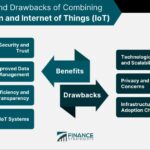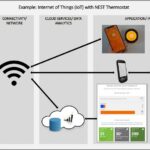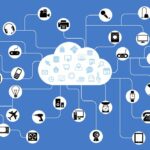The Future of IoT in Healthcare holds great promise in revolutionizing the healthcare industry. By leveraging the power of IoT devices and technologies, healthcare providers can enhance patient monitoring and care, improve efficiency in healthcare operations, enable remote healthcare services, and secure IoT devices and data. However, there are also challenges and considerations in implementing IoT in healthcare, such as ensuring data privacy and security, integrating IoT with existing healthcare systems, addressing regulatory and compliance issues, and managing and analyzing big data in healthcare. Despite these challenges, there are emerging trends and innovations in IoT healthcare solutions, including artificial intelligence and machine learning in healthcare, wearable devices and remote patient monitoring, blockchain technology for secure healthcare data, and predictive analytics for early disease detection. The future of IoT in healthcare presents opportunities for enhanced patient engagement and empowerment, improved healthcare access in remote areas, cost reduction and operational efficiency, and ethical and legal implications that need to be carefully considered.
Key Takeaways
- IoT has the potential to revolutionize the healthcare industry by enhancing patient monitoring and care, improving efficiency, enabling remote healthcare services, and securing devices and data.
- Implementing IoT in healthcare comes with challenges such as data privacy and security, integration with existing systems, regulatory compliance, and managing big data.
- Emerging trends in IoT healthcare solutions include AI and machine learning, wearable devices, blockchain technology, and predictive analytics.
- The future of IoT in healthcare offers opportunities for enhanced patient engagement, improved access to healthcare in remote areas, cost reduction, and ethical and legal considerations.
- Healthcare providers need to carefully consider the benefits, challenges, and ethical implications of implementing IoT in their practices.
The Role of IoT in Revolutionizing Healthcare

Enhancing Patient Monitoring and Care
The advancement of IoT technology has greatly enhanced patient monitoring and care in healthcare settings. Through the use of connected devices and sensors, healthcare providers are able to continuously monitor patients’ vital signs and collect real-time data. This allows for early detection of any abnormalities or changes in a patient’s condition, enabling prompt intervention and treatment. Remote patient monitoring has become increasingly popular, allowing patients to receive care from the comfort of their own homes while still being closely monitored by healthcare professionals.
In addition to monitoring, IoT devices also facilitate patient engagement and self-care. Patients can use wearable devices to track their own health metrics, such as heart rate, sleep patterns, and activity levels. This empowers individuals to take an active role in managing their health and well-being.
To ensure the accuracy and reliability of IoT devices in patient monitoring, it is crucial to establish secure and robust data transmission protocols. Encryption and authentication mechanisms should be implemented to protect patient data from unauthorized access or tampering. Regular software updates and maintenance are also essential to address any vulnerabilities and ensure the smooth operation of IoT devices.
Improving Efficiency in Healthcare Operations
Improving efficiency in healthcare operations is a key goal for healthcare providers. By leveraging IoT technology, healthcare organizations can streamline processes and optimize resource allocation. One way IoT can improve efficiency is through real-time asset tracking. With the help of sensors and connected devices, healthcare facilities can monitor the location and status of medical equipment, ensuring that they are readily available when needed. This reduces the time spent searching for equipment and improves overall operational efficiency.
Another area where IoT can enhance efficiency is in inventory management. By using IoT-enabled inventory tracking systems, healthcare providers can automate the monitoring and replenishment of supplies. This not only reduces the risk of stockouts but also eliminates the need for manual inventory checks, freeing up staff time for more critical tasks.
In addition, IoT can optimize patient flow and reduce wait times. By collecting and analyzing data from various sources, such as electronic health records and real-time patient monitoring devices, healthcare providers can identify bottlenecks in the care process and make informed decisions to improve patient flow. This can result in shorter wait times, improved patient satisfaction, and better overall operational efficiency.
Overall, IoT has the potential to revolutionize healthcare operations by improving efficiency and optimizing resource allocation. By leveraging real-time data and automation, healthcare providers can streamline processes, reduce costs, and ultimately provide better care to patients.
Enabling Remote Healthcare Services
Enabling remote healthcare services is one of the key benefits of IoT in healthcare. With the integration of IoT devices and technologies, healthcare providers can now offer medical services to patients who are located in remote areas or have limited access to healthcare facilities. Telemedicine is a prime example of how IoT is revolutionizing remote healthcare services.
Telemedicine allows healthcare professionals to remotely diagnose and treat patients using video conferencing and other IoT-enabled devices. This not only improves access to healthcare for patients in rural or underserved areas but also reduces the need for patients to travel long distances for medical consultations. Patients can now receive medical advice, prescriptions, and even monitor their health conditions from the comfort of their own homes.
In addition to telemedicine, IoT also enables remote patient monitoring. IoT devices such as wearable sensors and smart home devices can collect and transmit real-time health data to healthcare providers. This allows healthcare professionals to remotely monitor patients’ vital signs, track medication adherence, and detect any abnormalities or changes in health conditions. By enabling remote healthcare services, IoT is transforming the way healthcare is delivered, making it more convenient, accessible, and efficient.
Securing IoT Devices and Data
Securing IoT devices and data is crucial in healthcare to protect patient privacy and prevent unauthorized access. With the increasing number of connected devices in healthcare settings, there is a higher risk of cyberattacks and data breaches. Encryption plays a vital role in securing IoT devices and data by encoding information to make it unreadable to unauthorized users. Additionally, authentication mechanisms such as passwords, biometrics, and two-factor authentication can help ensure that only authorized individuals can access the devices and data.
To further enhance security, healthcare organizations should regularly update and patch IoT devices to address any vulnerabilities. Implementing firewalls and intrusion detection systems can also help detect and prevent unauthorized access to IoT devices and data. It is important for healthcare providers to establish robust security policies and protocols to guide the secure deployment and management of IoT devices.
In summary, securing IoT devices and data in healthcare is essential to safeguard patient privacy and prevent cyber threats. By implementing encryption, authentication mechanisms, regular updates, and robust security policies, healthcare organizations can mitigate the risks associated with IoT devices and ensure the confidentiality and integrity of patient data.
Challenges and Considerations in Implementing IoT in Healthcare
Ensuring Data Privacy and Security
Data privacy and security are paramount in the implementation of IoT in healthcare. With the vast amount of sensitive patient data being collected and transmitted, it is crucial to have robust measures in place to protect this information from unauthorized access and breaches.
One important aspect of ensuring data privacy and security is encryption. By encrypting the data at rest and in transit, healthcare organizations can safeguard patient information from being intercepted or tampered with. Encryption algorithms such as AES (Advanced Encryption Standard) provide a high level of security and are widely used in IoT systems.
In addition to encryption, access control plays a vital role in protecting healthcare data. Implementing strong authentication mechanisms, such as two-factor authentication, can help prevent unauthorized individuals from gaining access to sensitive information. Access control policies should be implemented at various levels, including device, network, and application, to ensure comprehensive protection.
To further enhance data privacy and security, healthcare organizations should regularly conduct security audits and vulnerability assessments. These assessments help identify potential weaknesses in the IoT infrastructure and enable proactive measures to mitigate risks. It is also essential to stay updated with the latest security patches and firmware updates for IoT devices to address any known vulnerabilities.
In summary, ensuring data privacy and security in IoT healthcare requires a multi-layered approach that includes encryption, access control, regular security audits, and staying vigilant with updates and patches. By implementing these measures, healthcare organizations can protect patient data and maintain the trust of patients and stakeholders.
Integrating IoT with Existing Healthcare Systems
Integrating IoT with existing healthcare systems is a crucial step in leveraging the full potential of IoT in healthcare. It allows for seamless communication and data exchange between IoT devices and the existing infrastructure, enabling real-time monitoring and analysis of patient data.
One approach to integrating IoT with healthcare systems is through the use of interoperability standards. These standards ensure that different IoT devices and systems can communicate and share data effectively. For example, the use of HL7 (Health Level 7) standards allows for the integration of IoT devices with electronic health records (EHR) systems, enabling healthcare providers to access and analyze patient data in a unified manner.
Another important consideration when integrating IoT with existing healthcare systems is data security and privacy. With the increasing number of connected devices and the sensitive nature of healthcare data, it is crucial to implement robust security measures to protect patient information. This includes encryption of data, authentication mechanisms, and secure communication protocols.
In addition to interoperability and security, scalability is also a key factor in integrating IoT with existing healthcare systems. As the number of IoT devices and the volume of data generated continue to grow, healthcare organizations need to ensure that their systems can handle the increased load. This may involve upgrading infrastructure, implementing cloud-based solutions, or adopting edge computing technologies.
Overall, integrating IoT with existing healthcare systems holds great promise in improving patient care and operational efficiency. However, it requires careful planning, consideration of interoperability and security standards, and scalability to fully realize its potential.
Addressing Regulatory and Compliance Issues
In the rapidly evolving field of IoT in healthcare, addressing regulatory and compliance issues is of utmost importance. As healthcare organizations adopt IoT technologies to improve patient care and operational efficiency, they must navigate a complex landscape of regulations and standards to ensure the privacy and security of patient data.
One key challenge is ensuring compliance with data protection laws, such as the Health Insurance Portability and Accountability Act (HIPAA) in the United States. Healthcare providers must implement robust security measures to safeguard patient information and prevent unauthorized access.
Another consideration is the interoperability of IoT devices with existing healthcare systems. Standardization of protocols and data formats is crucial to enable seamless integration and data exchange between different devices and platforms.
To address these challenges, healthcare organizations can establish clear policies and procedures for IoT implementation, including regular risk assessments and audits. They can also collaborate with regulatory bodies and industry associations to stay updated on the latest guidelines and best practices.
Table: Key Regulatory and Compliance Considerations
| Consideration | Description |
|---|---|
| Data Privacy | Ensuring the confidentiality and integrity of patient data |
| Security | Implementing robust measures to protect against cyber threats |
| Interoperability | Enabling seamless integration and data exchange between devices and systems |
| Compliance | Adhering to relevant regulations and standards |
By addressing regulatory and compliance issues proactively, healthcare organizations can leverage the full potential of IoT technologies while ensuring the safety and privacy of patient data.
Managing and Analyzing Big Data in Healthcare
Managing and analyzing big data in healthcare is a complex task that requires advanced technologies and expertise. With the increasing adoption of IoT in healthcare, the amount of data generated has grown exponentially. Big data refers to large and complex datasets that cannot be easily managed and analyzed using traditional methods.
To effectively manage and analyze big data in healthcare, healthcare organizations are leveraging cloud computing and data analytics technologies. Cloud computing allows for the storage and processing of large volumes of data, while data analytics tools enable healthcare professionals to gain valuable insights from the data.
In addition to cloud computing and data analytics, healthcare organizations are also utilizing machine learning algorithms to analyze big data. Machine learning algorithms can identify patterns and trends in the data, helping healthcare professionals make more accurate diagnoses and treatment decisions.
To ensure the accuracy and reliability of the analyzed data, healthcare organizations must also address data quality and data privacy concerns. Data quality refers to the accuracy, completeness, and consistency of the data, while data privacy involves protecting patient information from unauthorized access or disclosure.
In conclusion, managing and analyzing big data in healthcare is crucial for improving patient outcomes and healthcare delivery. By leveraging advanced technologies and addressing data quality and privacy concerns, healthcare organizations can harness the power of big data to make informed decisions and provide personalized care.
Emerging Trends and Innovations in IoT Healthcare Solutions

Artificial Intelligence and Machine Learning in Healthcare
Artificial Intelligence (AI) and Machine Learning (ML) are revolutionizing the healthcare industry by enabling advanced data analysis and decision-making capabilities. AI refers to the simulation of human intelligence in machines that are programmed to think and learn like humans, while ML is a subset of AI that focuses on the development of algorithms and statistical models that allow computers to learn and make predictions from data.
In healthcare, AI and ML have the potential to transform various aspects of patient care and medical research. Here are some key applications:
- Medical Imaging: AI algorithms can analyze medical images such as X-rays, CT scans, and MRIs to detect abnormalities and assist in diagnosis.
- Predictive Analytics: ML models can analyze patient data to predict the likelihood of diseases, identify high-risk patients, and recommend personalized treatment plans.
- Virtual Assistants: AI-powered virtual assistants can provide patients with personalized health information, reminders, and guidance.
AI and ML technologies are continuously evolving and have the potential to improve healthcare outcomes, enhance patient experiences, and optimize resource allocation. However, it is important to address ethical considerations, data privacy, and the need for human oversight in implementing these technologies.
Wearable Devices and Remote Patient Monitoring
Wearable devices and remote patient monitoring have emerged as crucial technologies in the healthcare industry. These devices, such as smartwatches and fitness trackers, enable continuous monitoring of vital signs and health parameters, providing valuable insights into a patient’s well-being. By collecting real-time data, healthcare professionals can detect early signs of potential health issues and intervene promptly.
One of the key advantages of wearable devices is their ability to empower patients to take control of their own health. With the help of these devices, individuals can track their physical activity, sleep patterns, and even receive personalized health recommendations. This promotes a proactive approach to healthcare, encouraging individuals to make positive lifestyle changes and prevent the onset of chronic diseases.
In addition to personal health monitoring, wearable devices also facilitate remote patient monitoring. This is particularly beneficial for individuals with chronic conditions or those who require regular medical supervision. Through wearable devices, healthcare providers can remotely monitor patients’ vital signs and receive alerts in case of any abnormalities. This not only improves patient outcomes but also reduces the need for frequent hospital visits, resulting in cost savings and enhanced convenience.
To fully leverage the potential of wearable devices and remote patient monitoring, healthcare organizations need to ensure the security and privacy of the collected data. Implementing robust data encryption and access control measures is crucial to protect sensitive patient information. Additionally, healthcare professionals should be trained on how to effectively interpret and utilize the data generated by wearable devices, enabling them to make informed decisions and provide personalized care.
In conclusion, wearable devices and remote patient monitoring are revolutionizing healthcare by enabling continuous monitoring, empowering patients, and improving healthcare outcomes. As these technologies continue to evolve, it is essential for healthcare organizations to embrace them and integrate them into their existing systems to unlock their full potential.
Blockchain Technology for Secure Healthcare Data
Blockchain technology has emerged as a promising solution for ensuring the security and integrity of healthcare data. By leveraging decentralized and immutable ledgers, blockchain provides a transparent and tamper-proof platform for storing and sharing sensitive patient information. This technology enables healthcare organizations to securely manage electronic health records, clinical trials data, and other critical healthcare data.
One of the key advantages of blockchain in healthcare is its ability to enhance data privacy and security. With blockchain, patient data can be encrypted and stored in a distributed network, reducing the risk of unauthorized access or data breaches. Additionally, blockchain’s decentralized nature eliminates the need for a central authority, reducing the vulnerability to single points of failure.
In addition to data security, blockchain also offers benefits in terms of interoperability and data sharing. Through smart contracts and permissioned networks, healthcare providers can securely exchange patient data, ensuring seamless collaboration and continuity of care. This interoperability can greatly improve the efficiency and effectiveness of healthcare delivery.
To illustrate the potential impact of blockchain in healthcare, let’s consider a hypothetical scenario. Imagine a patient who needs to undergo a surgical procedure in a different city. With blockchain, their medical records, including pre-operative tests, allergies, and previous surgeries, can be securely accessed by the surgical team, ensuring accurate and personalized care. This eliminates the need for manual data transfer and reduces the risk of errors or omissions.
While blockchain technology holds great promise for secure healthcare data management, there are still challenges and considerations that need to be addressed. These include scalability, regulatory compliance, and the integration of blockchain with existing healthcare systems. However, with ongoing advancements and collaborations in the field, blockchain is poised to revolutionize the way healthcare data is stored, shared, and secured.
Predictive Analytics for Early Disease Detection
Predictive analytics is a powerful tool in healthcare that uses advanced algorithms and machine learning techniques to analyze large amounts of data and identify patterns that can predict the likelihood of disease development or progression. By leveraging data from various sources such as electronic health records, wearable devices, and genetic information, healthcare providers can gain valuable insights into individual patient health and make informed decisions for early intervention and personalized treatment plans.
One of the key benefits of predictive analytics in healthcare is its potential to detect diseases at an early stage when treatment options are more effective and less costly. For example, by analyzing a patient’s medical history, lifestyle factors, and genetic predispositions, predictive analytics can identify individuals who are at a higher risk of developing conditions such as diabetes, cardiovascular diseases, or certain types of cancer. This allows healthcare providers to implement preventive measures, such as lifestyle modifications or targeted screenings, to mitigate the risk and improve patient outcomes.
In addition to early disease detection, predictive analytics can also be used to monitor disease progression and treatment response. By continuously analyzing patient data, healthcare providers can track changes in symptoms, biomarkers, and treatment outcomes to optimize care plans and make timely adjustments. This proactive approach not only improves patient outcomes but also reduces healthcare costs by minimizing hospitalizations, emergency visits, and unnecessary procedures.
To fully leverage the potential of predictive analytics in healthcare, there are several considerations that need to be addressed. First and foremost, data privacy and security are paramount. As predictive analytics relies on sensitive patient information, robust security measures must be in place to protect data from unauthorized access or breaches. Additionally, interoperability and data integration are crucial to ensure seamless data exchange between different healthcare systems and devices. Standardization of data formats and protocols is essential to enable effective data sharing and analysis.
Furthermore, healthcare organizations need to invest in the necessary infrastructure and expertise to implement predictive analytics successfully. This includes acquiring and maintaining advanced analytics tools, establishing data governance policies, and training healthcare professionals in data interpretation and decision-making. Collaboration between healthcare providers, technology vendors, and regulatory bodies is also essential to address legal and ethical considerations, such as informed consent, data ownership, and algorithm transparency.
In conclusion, predictive analytics holds great promise in revolutionizing healthcare by enabling early disease detection, personalized treatment plans, and improved patient outcomes. However, its successful implementation requires careful consideration of data privacy, interoperability, infrastructure, and expertise. By harnessing the power of predictive analytics, healthcare providers can proactively identify and manage health risks, leading to a more efficient and patient-centric healthcare system.
The Future of IoT in Healthcare: Opportunities and Challenges

Enhanced Patient Engagement and Empowerment
Patient engagement and empowerment are crucial aspects of healthcare that can be greatly enhanced through the use of IoT technology. By leveraging IoT devices and applications, healthcare providers can enable patients to actively participate in their own care and make informed decisions about their health.
One way IoT promotes patient engagement is through remote monitoring. IoT devices such as wearables and sensors can collect real-time data on patients’ vital signs, activity levels, and medication adherence. This data can be transmitted to healthcare providers, allowing them to monitor patients’ health remotely and intervene when necessary. Patients can also access this data through mobile apps or online portals, empowering them to track their progress and take proactive steps to manage their health.
Another benefit of IoT in patient engagement is the ability to provide personalized and targeted interventions. IoT devices can deliver personalized health recommendations, reminders, and educational content based on individual patient data. This not only helps patients stay engaged in their care but also improves their understanding of their health conditions and treatment plans.
In addition, IoT can facilitate communication and collaboration between patients and healthcare providers. Through IoT-enabled platforms, patients can easily communicate with their healthcare team, schedule appointments, and access their medical records. This seamless communication enhances patient-provider relationships and ensures that patients have timely access to the care they need.
Overall, IoT technology has the potential to revolutionize patient engagement and empowerment in healthcare. By leveraging IoT devices and applications, healthcare providers can empower patients to take an active role in their own care, improve their health outcomes, and enhance the overall healthcare experience.
Improved Healthcare Access in Remote Areas
Improved healthcare access in remote areas is one of the key benefits of IoT in healthcare. With the help of IoT devices and technologies, healthcare services can reach even the most remote and underserved areas. Telemedicine is a prime example of how IoT is revolutionizing healthcare access in remote areas. Through telemedicine, patients can receive medical consultations and treatment remotely, eliminating the need for them to travel long distances to access healthcare facilities.
In addition to telemedicine, IoT-enabled mobile clinics are also playing a crucial role in improving healthcare access in remote areas. These mobile clinics are equipped with IoT devices and technologies that enable healthcare professionals to provide medical services directly to patients in remote locations. Mobile clinics can bring essential healthcare services, such as diagnostics, vaccinations, and basic treatments, to areas where access to healthcare is limited.
To further enhance healthcare access in remote areas, IoT can also be used to establish healthcare networks. These networks connect healthcare facilities, clinics, and hospitals in remote areas to larger healthcare systems, allowing for seamless sharing of patient information and access to specialized medical expertise. By leveraging IoT, healthcare providers can collaborate and consult with experts from anywhere in the world, ensuring that patients in remote areas receive the best possible care.
Cost Reduction and Operational Efficiency
Cost reduction and operational efficiency are key benefits of implementing IoT in healthcare. By leveraging IoT devices and technologies, healthcare organizations can streamline processes, automate tasks, and optimize resource allocation. This can lead to significant cost savings and improved operational efficiency.
One way IoT can contribute to cost reduction is through predictive maintenance. IoT devices can continuously monitor the condition of medical equipment and alert healthcare providers when maintenance is required. This proactive approach helps prevent equipment failures and reduces downtime, ultimately saving costs.
Another area where IoT can drive operational efficiency is inventory management. IoT sensors can track the usage and availability of medical supplies and equipment in real-time. This enables healthcare organizations to optimize inventory levels, reduce waste, and ensure timely replenishment.
In addition, IoT can facilitate remote monitoring and telemedicine, which can reduce the need for in-person visits and hospitalizations. This not only improves patient convenience and access to care but also reduces healthcare costs.
Overall, the integration of IoT in healthcare holds great potential for cost reduction and operational efficiency. By leveraging IoT technologies, healthcare organizations can optimize processes, improve resource allocation, and enhance patient care.
Ethical and Legal Implications of IoT in Healthcare
The rapid advancement of IoT in healthcare brings about various ethical and legal implications that need to be carefully considered. Privacy is one of the primary concerns, as the collection and sharing of sensitive patient data raise questions about data protection and consent. Healthcare organizations must ensure that proper security measures are in place to safeguard patient information and comply with data privacy regulations.
Another important consideration is data ownership. With the increasing use of IoT devices, there is a need to determine who owns the data generated by these devices. Clear guidelines and agreements should be established to address this issue and ensure that patients have control over their own data.
In addition, ethical dilemmas may arise when using IoT in healthcare. For example, the use of AI and machine learning algorithms to make medical decisions raises questions about the responsibility and accountability of these algorithms. It is crucial to establish ethical frameworks and guidelines to ensure that the use of IoT technologies in healthcare is done in a responsible and transparent manner.
To navigate these ethical and legal challenges, healthcare organizations should consider the following:
- Implement robust data security measures: Encryption, access controls, and regular security audits can help protect patient data from unauthorized access.
- Establish clear data ownership policies: Clearly define who owns the data generated by IoT devices and establish agreements with patients regarding data usage and sharing.
- Develop ethical guidelines: Create guidelines that address the responsible use of AI and machine learning algorithms in healthcare to ensure patient safety and trust.
As the IoT continues to revolutionize healthcare, it is essential to address the ethical and legal implications to ensure the responsible and beneficial use of these technologies.
Conclusion
In conclusion, the future of IoT in healthcare holds immense potential for transforming the way we approach healthcare. With the ability to collect and analyze vast amounts of data in real-time, IoT devices can enable more personalized and efficient patient care. From remote patient monitoring to smart medical devices, the integration of IoT technology can improve patient outcomes, reduce healthcare costs, and enhance the overall healthcare experience. As we continue to advance in this field, it is crucial to prioritize data security and privacy to ensure the trust and adoption of IoT solutions in healthcare. The future is bright for IoT in healthcare, and it is poised to revolutionize the industry.
Frequently Asked Questions
What is the role of IoT in healthcare?
IoT plays a crucial role in revolutionizing healthcare by enhancing patient monitoring and care, improving efficiency in healthcare operations, enabling remote healthcare services, and securing IoT devices and data.
What are the challenges in implementing IoT in healthcare?
Some of the challenges in implementing IoT in healthcare include ensuring data privacy and security, integrating IoT with existing healthcare systems, addressing regulatory and compliance issues, and managing and analyzing big data in healthcare.
What are the emerging trends and innovations in IoT healthcare solutions?
Some of the emerging trends and innovations in IoT healthcare solutions include the use of artificial intelligence and machine learning in healthcare, wearable devices and remote patient monitoring, blockchain technology for secure healthcare data, and predictive analytics for early disease detection.
What are the opportunities and challenges for the future of IoT in healthcare?
The future of IoT in healthcare presents opportunities such as enhanced patient engagement and empowerment, improved healthcare access in remote areas, cost reduction and operational efficiency. However, it also raises ethical and legal implications that need to be addressed.
How does IoT enhance patient monitoring and care?
IoT enables continuous and remote monitoring of patients, allowing healthcare providers to track vital signs, detect abnormalities, and provide timely interventions. This leads to improved patient outcomes and personalized care.
What are the benefits of wearable devices and remote patient monitoring in healthcare?
Wearable devices and remote patient monitoring enable real-time tracking of health parameters, early detection of health issues, and remote healthcare services. This improves patient convenience, reduces hospital visits, and enhances overall healthcare delivery.




